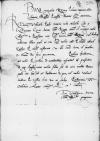Reverendissimo in Christo Patri, domino ⌊Ioanni episcopo Varmiensi⌋ sincere nobis dilecto
⌊Bona⌋ Dei gratia regina ⌊Poloniae⌋, suprema dux ⌊Lituaniae⌋, ⌊Russiae⌋, ⌊Prussiae⌋, ⌊Masoviae⌋ etc. domina
Reverende
in Christo Pater sincere nobis dilecte.
Cum is generosus Czerni sacrae ⌊maiestatis regiae⌋, domini et coniugis nostri colendissimi, in ⌊Prussiam⌋ cum litteris sacrae maiestatis regiae iret aulicus, noluimus illum pati, ut sine litteris nostris ad Paternitatem Vestram abiret, quibus Paternitatem Vestram visitamus ac illi omnia bona et fausta a Domino Deo fieri precamur. Praeterea hortamur, ut nobis Paternitas Vestra de novitatibus rescribat et praesertim de ⌊rege Angliae⌋, cuius matris filius sit. Ita enim multas uxores ⌊pater⌋ eius ha[bu]it, ut dubitamus(!), de qua sit natus.
Valeat tandem Paternitas Vestra bene diu ac felix.
⌊Piotrcovia⌋, XV octobris anno Domini M-o D-o XLVII.
Ex commissione sacrae maiestatis reginalis propria

